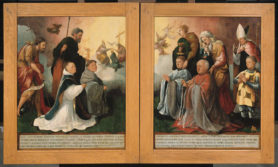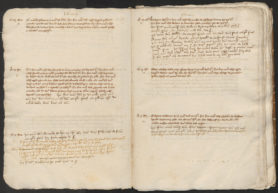Introduction
The contents of the database
Medieval Memoria Online provides a database that is accessible free of charge, with inventories and descriptions of objects and texts that had a function in the medieval commemoration of the dead in the area that is currently the Netherlands, until 1580. These are:
- Tomb monuments and floor slabs
- Memorial pieces (painted and/or sculpted artworks)
- Memorial registers (administrative and liturgical sources)
- Narrative sources that fulfilled functions in the commemoration of the dead
The database also contains basic information on the institutions in which the sources functioned.

Exterior wings of a triptych with four canons and a knight of the Lokhorst family. Several members of this family were canons in Utrecht, see MeMO memorial object ID 644and ID 749.
Researchers of medieval memoria consider the commemoration of the dead (i.e. memoria) a complex phenomenon, in which prayer for the care of the souls of the deceased, the care for the poor and the sick, commemoration of the deeds of the living and the dead, and political aspects are inextricably linked.
Target groups
The MeMO database is intended for:
- researchers of the commemoration of the dead in the Middle Ages and the Early Modern Period
- local historians, genealogists and researchers of heraldry who carry out research into ancient families
- museum curators
- teachers, pupils and students who wish to write a paper or a thesis
- anyone with a general interest in the Christian art and culture of the Middle Ages
How to use the database
Searching and navigating the database can be done in four ways:
- Browse database: search using filters; intended for global searches
- Search database: search using a search form; intended for advanced searches and using a combination of search criteria
- Quick search: searching institutions in a province or town
- Full text search: searching free text and names using Google; intended to search all fields

Pages from a calendar with memorial services of the Utrecht cathedral chapter, f. 7v-8r, mentioning almost exclusively members of the nobility and the clergy among whom not only canons of the cathedral but also canons from other chapters, see MeMO text carrier ID 390.
One of these options may be more suited to what you wish to do with the database than another. Before getting started it is therefore useful to first have a look at the introductory texts. They provide background information and the explanation of the design of the database. In each chapter you find a summary followed by a more extensive text. This information is available under the tabs in the left-hand bar. The first tab provides a full table of contents of the background information. Each chapter can be read as a stand-alone text, and the entire text is also available in PDF format to download and print below.
- The commemoration of the dead in the Middle Ages
- Purpose and intended users
- Objects
- Text carriers and texts
- Institutions from which the objects and texts originate
Additional information:
- For directions on how to cite the MeMO database see paragraph 8 or the Manual
Technical information:
- Compatible browsers: Safari, Mozilla Firefox, Chrome and Internet Explorer
- Compatible platforms: Windows, Mac OS X and iPad

